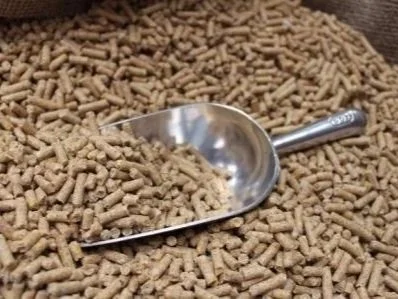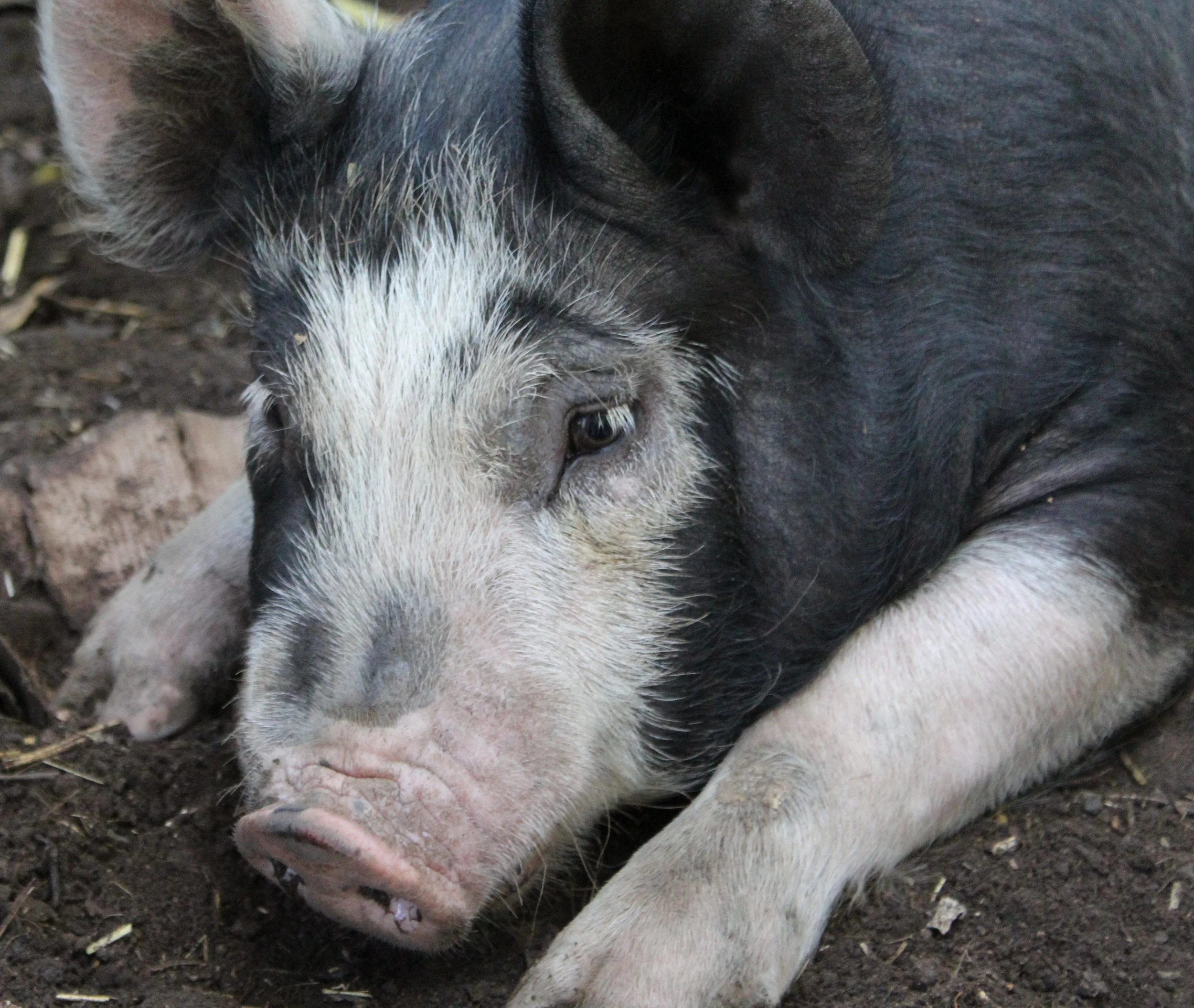
Farm Fresh Pork
Humanely Raised 2025-26
What’s a hog share?
Milkshare members and Farm School families may purchase a portion of a hog raised here at Farm School. You can split it with one or more other families. There are 1/8 shares, 1/4 shares and 1/2 shares usually available. If we harvest the hogs when they weigh about 260- 300 pounds, they yield about 150-200+ pounds of pork, soup bones and some lard to be rendered.
1/2 share is about 75+ up pounds of pork and soup bones + lard
1/4 share is about 38+ pounds
1/8 share is about 19+ pounds
Frequently Asked Questions
-
Berkshires are what gourmet chefs source.
Berkshires are a heritage breed that has excellent intramuscular marbling which is what makes it taste moist and delicious, unlike supermarket pork which is dry.
Berkshires don’t mature as fast as commercial hogs but also don’t take a full year to grow to 280 pounds though like most heritage breeds.
Meishans are a Chinese heritage pig also known for fine intramuscular fat. Farmers like to have Meishans as mothers as they are excellent moms, have very large litters (they have 16 to 20 teats instead of 12 to 13!), and are ready to breed by 3-4 months old!
Meishans also have mellow dispositions making them easier to be around. But they do mature more slowly than Berkshires.
This cross should make for a delicious but not-too-slow growing hog. We have had Red Wattle Berkshire crosses before as well as pure Berkshires.
-
You can’t find Berkshire meat on the grocery store shelf because factory farms use different breeds that are leaner, mature faster, and reach a uniform size.
Factory farming requires pigs to be more like widgets that all reach harvesting weight at exactly the same time and be the same shape for efficient production on factory-like farms..
This makes for a more efficient slaughter process when every hog is the same size and shape.
This is also why store-bought pork is often very dry as hogs were bred in the 1950s-1990s for leaner meat when Americans were on a no-fat kick. But the trade off is dry less flavorful meat.
Chefs know that fat is where the flavor is, so we choose breeds with intramuscular marbling (white flecks of fat in the muscles) for a delicious flavor.
-
EVERYTHING. Pigs are omnivores. Opportunists.
At their ranch they were eating left overs from the garden, cracked corn and nursing. They are just weaned (pigs can be weaned at 3-4 weeks. These ones nursed for twice that long.)
Bring your table scraps as long as it isn’t pork. Yes, meat is okay, but no chicken bones until the pigs are older.
Bring your pumpkins, fallen fruit.
If you have a friend who runs a brewery or small grocery store talk to them about getting spent brewers grains or produce that is no longer pristine or backed goods.
-
When they reach roughly 280 pounds.
Best guess is April or May.
We don’t have a thousand dollar livestock scale and pigs really don’t like being picked up (nor can you once they are over 100 pounds) so we eyeball 280#. This will be our fourth round of hogs so we have a decent sense of what a nearly 300 pound pig looks like.
-
They are curious but cautious; they were around kids on their farm but they aren’t trotting up to you yet.
Eventually, they’ll roll over for belly rubs, like a dog.
They are very smart, very strong, and very curious.
Meishans and Berkshires are known for being docile. Yet each pig has it’s own personality and temperament. We respect their strength, size, and powerful jaws.
-
About six weeks.
-
Date listed is the date they consumed each batch of 100 pounds of pig pellets. (Doesn’t include fresh fruits, veggies, older grains/rice.) They arrived on October 6.
-
We can only weigh them for a month or two then they get too strong and too heavy.
10/6
What does it cost and how does it work?
It cost roughly $1400 - 1700 to raise one hog, depending upon current grain prices.
Piglet- $150 (expected price was $200)
Labor - $200
Feed - $600 to 700
Feed is the biggest variable, especially given fluctuating tariffs. As of September 29, hog pellets -which are mostly grain and minerals- are $0.50/pound. One hog will eat 1100-1400 pounds of grain: about 4-6 pounds per 1 pound of weight gained.
Bedding & incidentals - $120 (deworming meds, bedding, fly predators, water troughs, etc. )
Harvesting cost - $175-200 charged by the mobile butcher (Schraners) who comes to our property to humanely slaughter the hog while it sleeps. A quick, stressless end.
Cut and wrap cost- $300 butcher’s fee — Red Barn Market. It’s calculated by hanging weight and is done by Red Barn Market in Escondido which will cut and wrap to your group’s specifications.
We split the consumable costs (i.e. feed and bedding/incidentals) between our hog and the shared hog 40% (our hog)-60% other hog. This pays for our labor of about 30-45 minutes every day for 6 months plus a few long Saturdays. Labor includes: shoveling pig manure daily, feeding & watering daily, changing bedding, bi-monthly setting up new enclosures, rain and sun shelters, plus the travel to a rural part of the county to get the piglets. The other consumable cost is incidental infrastructure repair— usually a new watering trough which they break every year. Pigs are strong, curious, and always shoving things around to root for food which makes them really good at busting a few things.
Tracking 2025-26 Hog Costs
Piglet price: $150
They weighed 21 & 22 pounds on Monday Oct 6, 2025. They traveled in a large dog crate from their farm in Alpine to Farm School on Mt. Helix.
2025-26 Feed
9/23 - $25 (one 50# bag hog grower pellets)
Yucca extract (supports digestive health, reduces manure odor from ammonia, enhances nutrient absorption)
Bedding, Fly Management, Medicines
Bedding
We use a combination of sand plus sawdust from a local furniture maker.
$38 1/2 ton sand - 9/23
$ PDZ Stall refresh 10/7 (binds ammonia in urine to reduce odors
$ Yucca extract
Fly predators & Traps
Fly predators are tiny parasitic wasps the size of ants which lay eggs in fly larva killing maggots before they can hatch.
$
Berkshire Breed
We raise Berkshires or Berkshire-crosses. Chefs at premier restaurants request their buyers to source Berkshires because they are considered the best pork. Berkshires are hritage breeds known for intermuscular marbling. This fat within the cuts makes for tender, juicy, flavorful pork.
2021-22 Pig Share Data
Hamsolo - purebred Berkshire
April 18th, 2022 harvest date
5 a.m.- Butcher requires $250 per hog at time of slaughter then $150 at pick up.
Decide how you want your pork: thick or thin chops? how many chops per package? large or small hams? leg steaks? seasoned pork sausage? smoke your own bacon and hams or pay extra to have Daniel smoke and cure it?
Feed & bedding costs for each pig Jan 31- to present are $455
First Hog Harvested
February 12, 2022
Hamlet reached an estimated minimum butcher weight of about 280 pounds and the butcher had a rare opening in his schedule so Hamlet was butchered this Saturday morning. His hanging weight (sans head, skin, trotters and internal organs) was 171 pounds.
Next available appointment for the butcher is 9 weeks out, April 18th, for Chiccharon and Lady MacBacon. We estimate Chiccharon is about 200 pounds now and Lady MacBacon is 240.
2021-22 Piglets
October 23, 2021
We purchased and picked up three piglets from a breeder in Banning, CA. They made the trip home in a giant dog crate. Each weaned pig weighs between 25-40 pounds. Or so we estimate. We haven’t picked them up yet— pigs aren’t fans of being lifted off the ground.
Seven week-old barrow (castrated male) 3/4 Berkshire-Red-Wattle cross
Eight week-old barrow purbred Berkshire, named Hamlet
Ten week-old gilt (young female) 3/4 Berkshire-Red-Wattle cross
Names decided by families: Hamlet, Lady McBacon, Chicharron.
Feed
It’ll take about 850-1000 pounds of hog pellets to get each piglet from 30 pounds to 300 pounds in six to eight months. Their feed conversion ratio is about 3:1.
They’ll also eat just about whatever a human eats. They prefer carbs/grains, fruit, and meat/eggs/dairy (no pork allowed though) if given a choice among table scraps. Pumpkins too but when they’re young we bake those for them.
We’re getting produce donations from a small food bank which send us their bruised fruit and vegetables once a week. And another family donated old canned rice, wheat, oats, dehydrated milk and carrots which we cook for them in a crock pot as whole grains are hard to digest.
If you frequent a favorite brewery, ask about spent brewers grains.
Oct 22 $36 100 lbs feed ($18/bag - Tractor Supply)
Oct 13 $21 10 lbs diatomaceous earth (natural dewormer)
Nov 3 $54 150 lbs feed ($18/bag - Tractor Supply)
Nov 16 $72 150 lbs feed ($24/bag - Carter’s)
Nov 30 $74 200 lbs feed ($18.50/bag - Tractor Supply)
Dec 13 $74 200 lbs feed ($18.50/bag - Tractor Supply)
Dec 22 $222 600 lbs feed ($18.50/bag - Tractor Supply)
Jan 10 $17 Safeguard - livestock dewormer
Jan 15 $222 600 lbs feed ($18.50/bag - Tractor Supply)
Jan 31 $95.00 250 lbs feed ($19.00/bag -Tractor Supply - price increase)
Just two pigs from here down as Hamlet was butchered on 2/12
The butcher told us that he feeds his hogs 50% Cracked corn & 50% NutreBeef Grower Finisher because the best looking pork he’s ever butchered came from a hog that was fed that. It had intramuscular marbling (fat) which was evident even when the meat was hot (typically one can’t see that fat until the meat is chilled). This 50-50 split will average out to $17.70 per 50 pounds. We’ll add that to our feed regimen, which includes fresh fruits and vegetables and Dumor Hog Grower & Finisher and see how it goes.
Feb 11 $114 300 lbs feed ($19.00/50#bag - Tractor Supply “Hog Grower” by Dumor
Feb 19 $64 150 lbs feed ($21.33/ 50#bag + shipping - Tractor Supply “NutreBeef grw/finisher” by Nutrena
Feb 22 $99 300 lbs feed ($19/50# bag of Dumor Hog grower & $14/50# bag cracked corn)
Hogs are wasting more of the cracked corn and Nutrebeef grower-finisher which suggests they don’t like the taste of it or they are cherry picking their favorite bits and scattering the other parts so we’ll not purchase much more of that.
Mar 1 $121 300 lbs feed ($19.30 — price increase Dumor hog grower & $21.50 Purena Pig)
Mar 8 $39 100 lbs feed ($19.30/50# bag of Dumor Hog grower)
Mar 15 $52 150 lbs feed ($19.30/50# bag of Dumor Hog grower & $12.50/50 All Stock Sweet)
Mar 23 $21.50 50 lbs feed ($21.50/50# bag of Ace Hi grower)
Mar 25 $43 100 lbs feed ($21.50/50# bag of Ace Hi grower)
Mar 28 $43 100 lbs feed ($21.50/50# bag of Ace Hi grower)
April 1 $114 (4 bags All Stock Sweet feed, 3 Dumor hog grower — price increase to $20/50#)
Bedding
Hogs need a warm, dry place to sleep at night. They like to snuggle up in their hut in a pile of fresh straw.
We also toss autumn leaves in their pen, especially from pecan trees as they like to hunt for pecans in the leaf litter. In their preferred dunging corner, we add pine pellets which is compressed pine saw-dust or pelletized corn cob to absorb moisture. We also add stall-dry or sani-care to their dunging corner to bind to ammonia to reduce fly-attracting odors. Both are harmless to the soil and animals.
Oct 22 $10 1 straw bale
Nov 3 $20 Stall dry deodorizer/moisture absorption
Nov 3 $17 pelletized pine horse bedding
Nov 23 $30 pelletized pine horse bedding
Dec 22 $29 pelletized pine horse bedding
Feb 1 $44 pelletized pine horse bedding (4 bags), stall deodorizer (2 bags)
Feb 12 $24 Fly traps (2 plus a refill, unseasonable heat has brought out early flies)
Feb 22 $8 pelletized pine horse bedding
Mar 1 $17 pelletized pine horse bedding
Mar 8 $24 pelletized pine horse bedding
April 4th— projected $25-6 pelletized pine horse bedding
Piglets
We picked out the biggest and most vigorous shoats from three litters at Outspoken Ranch.
One purebred Berkshire barrow, and two 3/4 Berkshire-Red Wattle crosses, a gilt (young girl) and barrow (castrated male). The Red Wattle adds a little more size and a excellent mothering abilities which is important to the breeder and that is the source of the red color and wattle on the red barrow.
October 22 $360 ($120 each)
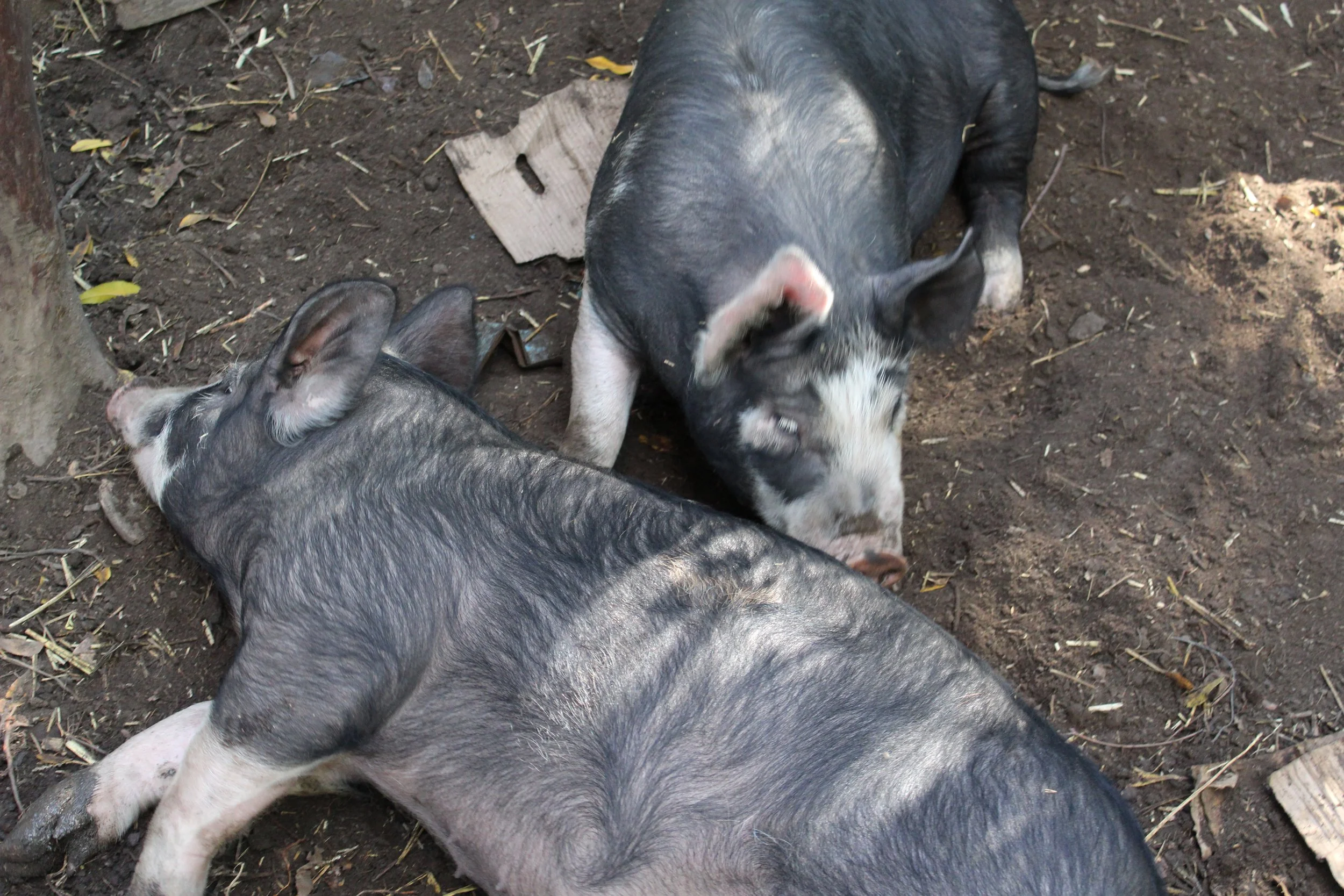
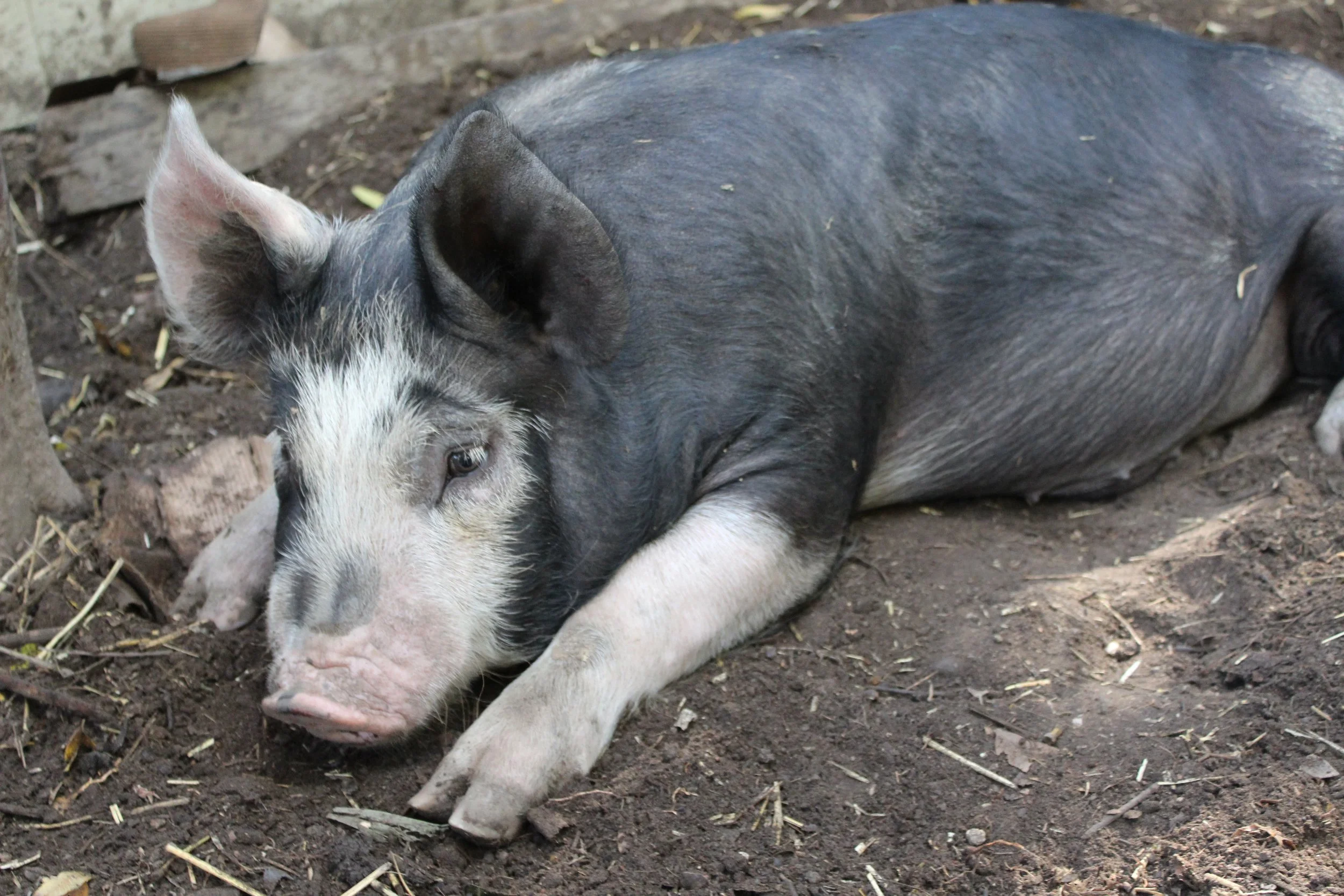
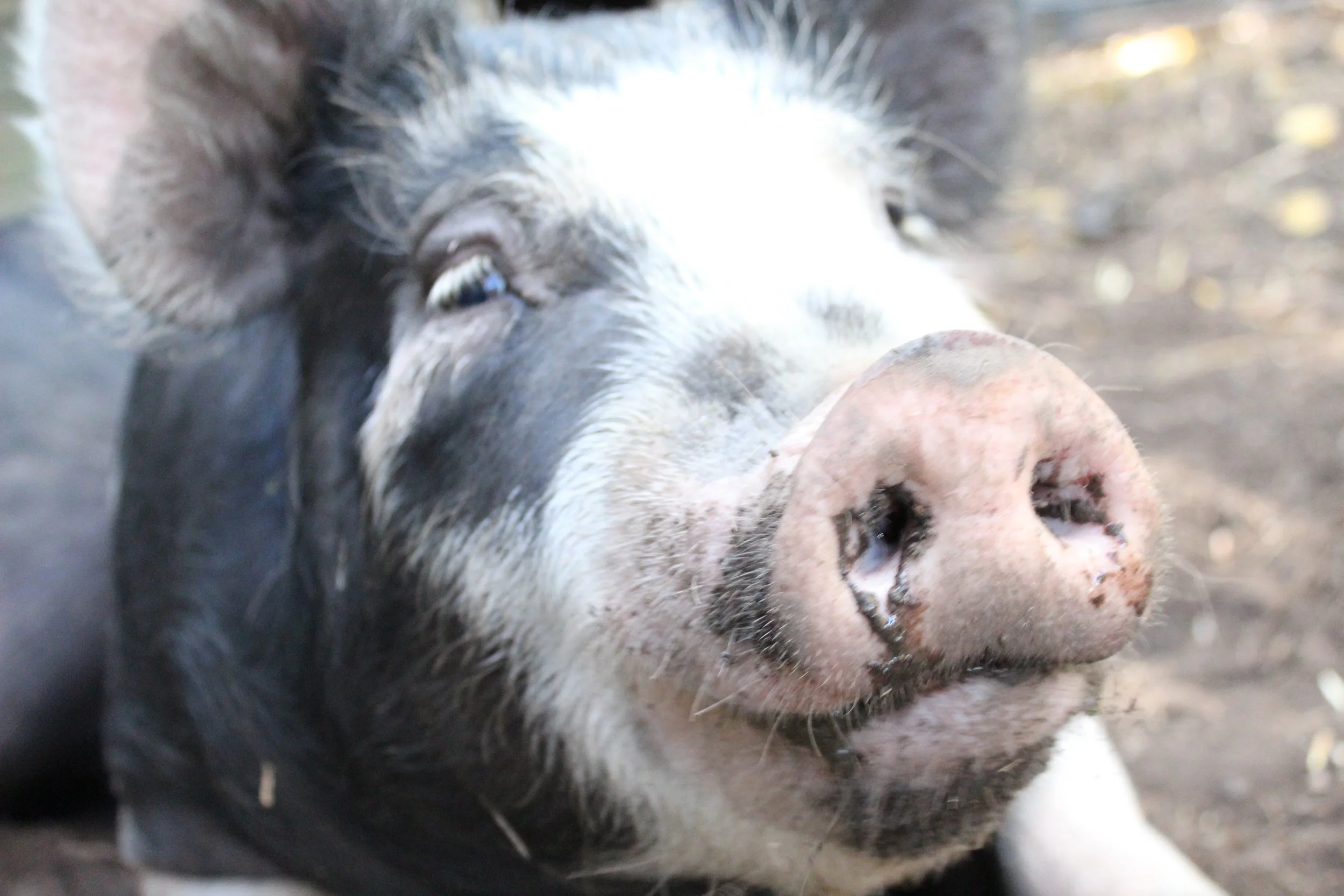




Last year’s pigs: Kalua and Napolean at about 240-260 pounds.
Purchasing a pig-share
October 22, 2021
We have no more pig-shares available this year. They are all claimed.
October 16, 2021
We're going to be getting piglets again in a week or so for humanely raised pork. We like to get two piglets since hogs are social creatures and enjoy having someone to wrestle with and steal food from.
We only need one hog for our family for 6 to 8 months, so we’ll have a second hog available for a pig share if you'd like to buy a whole pig or buy a 1/4 or 1/2 of a hog to be raised here. If this is interesting to you, read on.
BREED
We raise Berkshires or Berkshire-Red Wattle crosses. Berkshires and Red-Wattles are heritage breeds prized for intermuscular marbling which makes for tender, juicy, flavorful pork.
These breeds aren't on the shelf at any store because factory farms use different breeds that are leaner and mature faster and reach a uniform size. Factory farming requires pigs to be more like widgets that all reach harvesting weight at exactly the same time and be the same shape. This makes for a more efficient slaughter process. This is also why store-bought pork is often very dry as hogs were bred in the 1950s-1990s for leaner meat when Americans were on a no-fat kick. But the trade off is dry less flavorful meat.
We also choose this breed because these are also hogs with a decent temperament which is important in a creature weighing 300 pounds. Our last hogs liked belly rubs and were super funny.
HOW MUCH MEAT ARE WE TALKING ABOUT?
150-180 POUNDS including bones and lard
This is about two really big boxes of meat -- larger than banker's boxes. So it would completely fill up a large bottom freezer. You'd either need either a very big freezer compartment, a spare freezer or go in on a pig with another family.
SLAUGHTER, CUT & WRAP
The hogs are killed and slaughtered here at our property in their sleep so there is no traumatic transport and thus no stress hormones affecting the meat. The butcher has been doing this for 20+ years. He then askes you exactly how you want your pork cut up: how thick you want your chops? small hams? huge hams? leg roasts? how much sausage? etc. He’ll walk you through this process. He then takes it back to his shop where he cools the meat then cuts and wraps it according to your specifications. You can request one of eight difference types of sausage. If you want bacon or hams cured and smoked I can teach you how to do that or you can have those parts of the hog made into something else.
You can get cheaper pork at Costco but you can't get pork from pigs that had a good hog life or taste this good from a store.
COSTS
Rough costs to you are approximately $800-900 for about 150-180 pounds of tenderloin, ribs, chops, sausage, pork belly, hams, bacon, roasts and bones for bone broth or soup stock and lard for rendering. We made 4 quarts of pie and savory lard from the prime leaf lard (lard that sits on the kidneys and doesn’t smell like meat) and have another 10 pounds to render for soap making). Last time we did this the cost was $800 per pig but grain prices have gone up a bit and weanling piglets are 20% more expensive this year.
Cost breakdown:
$120-150 for 6 week old piglet
$400-450 in feed depending upon fluctuating grain prices, plus bedding for 5-6 months (roughly 1100 - 1400 pounds of feed to reach 300 pounds)
$350 for kill, cut, wrap (or you can do the slaughter and butcher yourself if you have a rifle and experience hunting/shooting livestock humanely, excellent knives and saws, and have a buddy or mobile crane who will help you lift at 300 pound pig and save yourself $350. We did this once with 100 pound hogs.)
We provide housing and labor. If you’re buying a full pig-share we split the feed costs 60:40%. (You purchase 60% of the feed; we purchase 40%). Our labor takes an 30 - 60 minutes every day for 6 months plus a few long Saturdays and includes: setting up the enclosures and rotating them around the yard, driving to Banning and back to pick up the pigs, hauling the feed from Lakeside each week, feeding and water them twice a day, shoveling the manure twice a day & burying the manure, adding new bedding daily. Thrice deworming the pigs. I'll also arrange for the butcher to come out if you want me do that too. I keep a ledger of feed, bedding, dewormer costs.
WHEN WILL THE HOGS BE READY TO HARVEST?
It takes about six months and 1000-1200 pounds of feed for a hog to grow from 20-35 pounds when we bring it home at 6-10 weeks old (think small dog size) to reach 300 pound harvesting weight. We anticipate that the hogs will be harvest weight around mid-April. I’ll teach your kids how to use a hog tape to estimate their weight.
If you have kids who you want to learn to work they can help shovel manure and feed once a week; it can be your own FFA mini-experience. You can bring food scraps for them to eat (no pork, please). You pay for the piglet up front and feed by the month.
Let me know if you're interested. We love doing this! We get a real kick out of the pigs, love the learning experience and like knowing that our meat is humanely raised.


